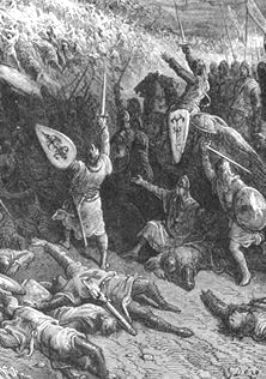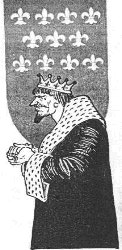| back | The
Third Crusade A new call for another crusade went out from the Pope, to once again to take Jerusalem from the Muslims. The Pope (now Gregory VIII), and the Kings of Europe answered his plea. Richard the Lion heart led an English army, but he and his fellow kings failed to drive Arabs from Jerusalem. Saladin and Richard the
Lionheart are two names that tend to dominate the Crusades. Both
have gone down in Medieval history as great military leaders. |
 |
 King Richard I |
|
 Emperor Frederick Barbarossa of Germany |
These were possibly
the three most important men in western Europe - such was the
importance of this crusade. It was to last from 1189 to 1192. King Frederick (of Germany) was drowned on his march across Europe. He was 70 years of age and his death shocked his army and only a small part of it continued to the Middle East. King Richard and King Philip (of
France) and their men
travelled by boat. They stopped their journey in modern day Sicily.
In March 1191, Philip then sailed to the port of Acre which was
controlled by the Muslims. |
|
|
 |
Richard had captured Cyprus
first before moving on to Acre. The port could not cope against such
a force and in July 1191, it fell to the Christians. However, the
siege had had its impact on Philip - he was exhausted and left for
France. Richard was left by himself. While in control of Acre, the Christians massacred 2000 Muslim soldiers who they had captured. Saladin had agreed to pay a ransom for them but somehow there was a breakdown in the process of payment and Richard ordered their execution. Richard was determined to get to Jerusalem and he was prepared to take on Saladin. The march south to Jerusalem was very difficult. |
|
|
The
Crusaders kept as near to the coast as possible to allow ships to
supply them. It was also slightly cooler with a coastal breeze.
Regardless of this, the Christians suffered badly from the heat and
lack of fresh water.
At night when the Crusaders tried
to rest, they were plagued by tarantulas. Their bites were poisonous
and very painful.
|
 |
 |
However, by now even Richard the Lionheart was suffering. He had a fever and appealed to his enemy Saladin to send him fresh water and fresh fruit. Saladin did just this - sending frozen snow to the Crusaders to be used as water and fresh fruit. Also in a later battle, when Saladin saw that Richards horse had been killed, Saladin sent him a new horse! Why would Saladin do this? There are several reasons. First, Saladin was a strict Muslim. One of the main beliefs of Islam is that Muslims should help those in need. Secondly, Saladin admired Richards, fighting skills, courage and bravery. The Muslim writer Baha described Richard as "....a very powerful man of great courage..." and "...a king of wisdom, courage and energy,.....brave and clever." Perhaps Saladin wanted to send his men into Richard's camp with the supplies and spy on what he had in terms of soldiers, equipment etc. |
|
What
Saladin's men found, was that Richard
only had 2,000 fit soldiers and 50 fit knights to use in battle.
With such a small force, Richard could not hope to take Jerusalem
even though he got near enough to see the Holy City.
Although Richard failed to retake Jerusalem, he organised a truce with Saladin - pilgrims from the west would once again be allowed to visit Jerusalem without being troubled by the Muslims. Neither Richard or Saladin particularly liked the truce but both sides were worn out and in October 1192, Richard sailed for western Europe never to return to the Holy Land.
|
 |
 |
. The Later Crusades Other crusades followed, including one, which involved peasants and children from the Rhineland and Southern France. These Crusades or Holy wars fought between the Christians and the Muslims to get Jerusalem back, were to last nearly 200 years.
|
 |


